Excerpts from Jim Conrad's
Naturalist Newsletter
entry from field notes dated July 3, 2022, taken on the eastern lower slope of Cerro de la Cruz, at an elevation of ~2700m (~8850 ft), just south of the community of El Pinar, Amealco de Bonfil, Querétaro, MÉXICO, (~N20.17°, ~W100.17°)
JUNIPER HAIRCUP
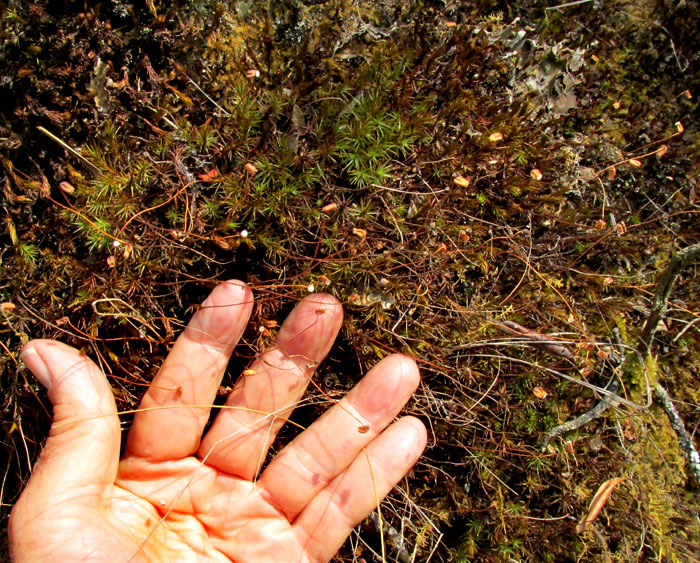
On the lower eastern slope of Cerro de la Cruz where the valley floor begins, many years ago someone cut into the slope for a now disappeared road, but the vertical, head-high, north-facing cut is still there, encrusted with mosses and lichens. At the very dry end of an extended dry season, most of the mosses lacked spore-producing capsules, usually needed for identification, but the above mosses retained theirs in a pale, dried-out condition. Moreover, this was an exceptionally large moss with distinctive-looking capsules, so maybe it could be identified without magnification.
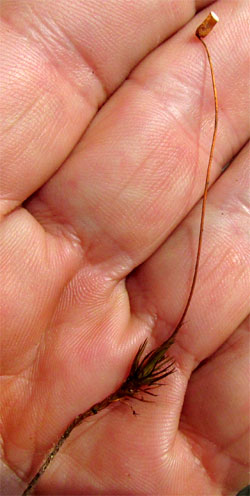
This moss was of the tuft-forming kind, its leaves forming dense clusters at the top of its stem. The spore-producing capsule, at the top, right of the picture at the right, was on an unusually long stem-like seta, and only a single seta arose from atop each moss stem. All of this moss's capsules, instead of standing upright atop the seta, hooked so strongly to one side that they remained horizontal. When a moss's capsule first forms, atop it there's a kind of cap, the calyptra, which it wears until it's time for spores to be released. Our moss's calyptras had fallen away, leaving the capsules with their mouths covered by white membranes called epiphragms or tympanums. Many moss capsules don't have such epiphragms, so this is a good field mark.

The epiphragms don't rupture to release spores from the capsules, but rather all around each epiphragm's edge there are tiny openings-- too small to appear in the above photograph -- between 64 short, slender teeth of both the epiphragm and the peristome beneath it. These 64 tiny openings provide a degree of control over how fast spores escape the capsule, the epiphragm preventing them all from dumping out at the same time.
The above capsules display conspicuous ridges running their lengths. Fresh capsules of this species are 4-angled. Our dried-out capsules have shrunk, producing extra ridges and furrows. Only certain kinds of moss produce angled capsules.
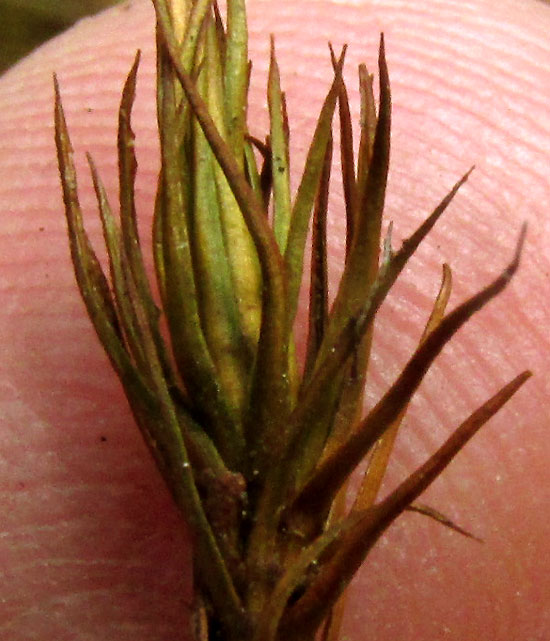
Our moss's leaves are straight, at least when dry, slender, closely overlapping, and gradually diminish toward sharp, stiff, somewhat orangish tips. The leaf margins bear no teeth, and the sides of the dried blades curl inward, but will spread out when moist.
Being such a large moss growing in large patches, all the details mentioned above led, and the fact that this is a common species throughout much of the world, enabled an identification without high magnification. It's POLYTRICHUM JUNIPERINUM, often known in English as Juniper Haircap moss.
The "juniper" part of the name probably comments on the similarity of our moss's narrow, sharp leaves with the evergreen leaves of juniper trees. The "haircap" part of the name is applied to many of the species in the moss family our moss belongs to, the Polytrichaceae. That's because the capsules of species in this family form with cap-like calyptras covering their tops, and those calyptras consist of a matted felt of hairs.
The Polytrichaceae currently consists of about 22 genera and around 260 species. Claudio Delgadillo-Mohya's 2014 publication "Biodiversidad de Bryophyta (musgos) en México" tells us that in Mexico we have 19 species belonging to the haircap family.
If you do an image search on the keywords "Polytrichum Mexico," mostly you'll see thumbnails of the Common Haircap, Polytrichum commune. However, that moss habitually bears leaves arising along a longer section of stem than our plant. Juniper Haircups constitute the second-most commonly featured thumbnails, and some of those images are of herbarium specimens whose anatomical features can be closely examined. As further confirmation of the identification, the lists of moss species published for our upland, semiarid region of central Mexico list Juniper Haircap but not any other Polytrichum species. The Juniper Haircap moss in general prefers drier habitats than other haircaps likely to be found here.
The Flora of North America describes the Juniper Haircap's habitats as "Exposed, well-drained, mostly acid soils in old fields and open woods, in openings following forest fire, on trailside banks and road cuts, on thin shallow soil overlying rocks, blowdowns and open ridge tops near timberline, only rarely in moist or wet situations; low to high elevations..." They occur in most of the world, including Antarctica.
The Plants For a Future website, pfaf.org, reports that infusions of whole plants of this species are powerfully diuretic -- cause increased urine flow. As such it's "very useful in the treatment of urinary obstructions, gravel etc, causing no nausea and suitable for long-term use."
Entry dated November 7, 2023, from notes taken near Cascadas de La Piedad waterfall 3kms NW of the community of San Pablo, municipality of Almeaco de Bonfil; bedrock of thick layers of compacted volcanic ash, or tuff; N20.1024°, W100.0019°, elevation 2360 meters (7750ft); extreme southern Querétaro state, MÉXICO
JUNIPER HAIRCUP, YOUNGER PLANT
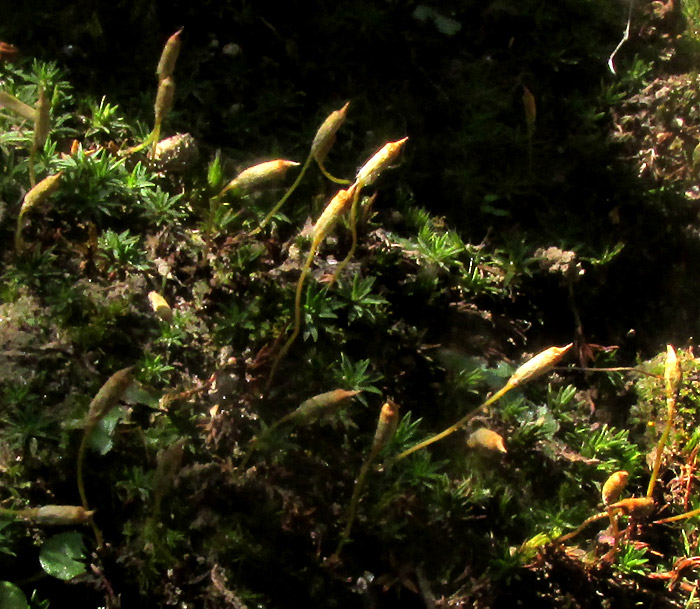
The above mosses seemed similar to Juniper Haircaps profiled in the previous entry, but the stalks, or setae, of the capsules shown above were much shorter, not reddish, and the capsules themselves were not angled toward the horizontal.
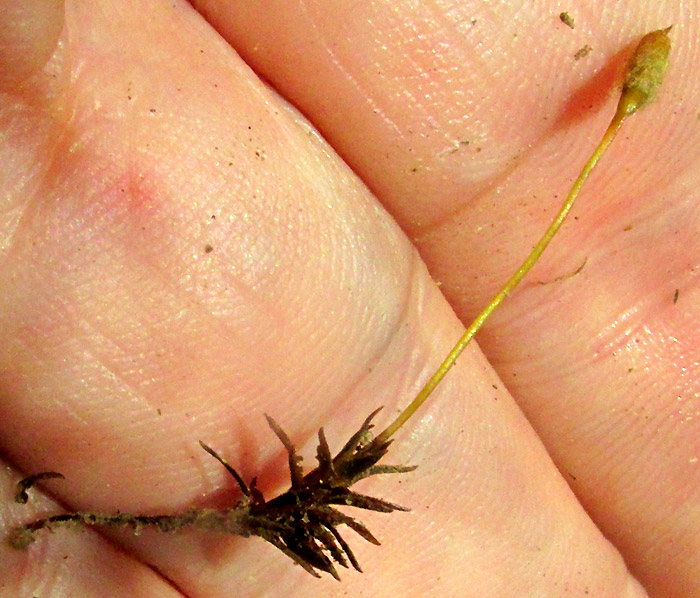
Unlike the mosses profiled earlier, this one's capsules still bore calyptras composed of densely interwoven, matted hairs. This is a feature of the genus Polytrichum, whose species commonly are called haircap mosses or just hair mosses. The earlier mosses' had been more advanced in their reproductive cycle and their calyptras had fallen off, enabling the capsules to release their spores.

Above, the hairy calyptra of one of our current mosses already is exposing the capsule below it, as it begins the process of falling off.

The current moss's leaves were more reddish brown and less slender than those of the earlier plants'.
Despite these differences, after looking at many pictures of similar species documented as occurring in upland central Mexico, it seems that again we Polytrichum juniperinum. The differences in appearance may be explained by our current mosses exhibiting an earlier stage in their capsules' development, as well as by their occupying a drier, more exposed environment than the earlier ones. Exposure to more sunlight, as well as the ongoing two-year severe drought, could account for the leaves' reddish-brown color and shorter, thicker appearance.
Other species also looking like our moss can be found, but they aren't documented for upland central Mexico. Still, without microscopic examination, one just can't be sure that long-distance wind dispersal of spores hasn't introduced something unexpected into our area.